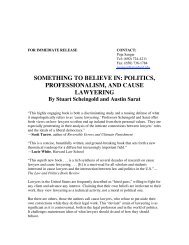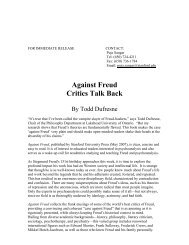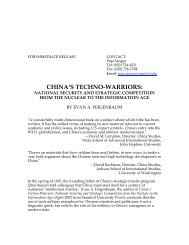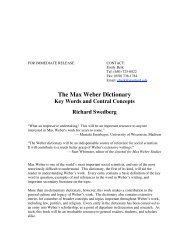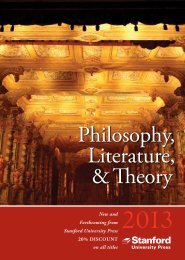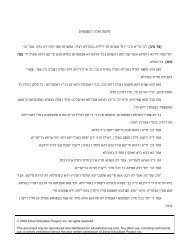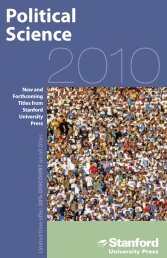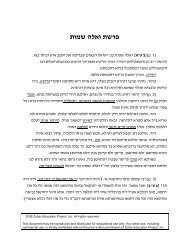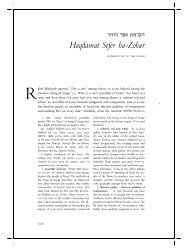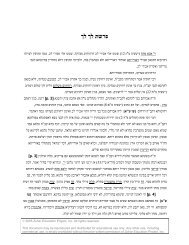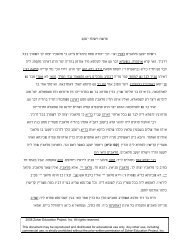Front Matter (PDF) - Stanford University Press
Front Matter (PDF) - Stanford University Press
Front Matter (PDF) - Stanford University Press
You also want an ePaper? Increase the reach of your titles
YUMPU automatically turns print PDFs into web optimized ePapers that Google loves.
of the nuances of Hebrew and Aramaic speech, its startlingtransformation<br />
priation<br />
of countless biblical verses, and the frequent subtle rereadings of the<br />
legacy that together comprise much of the Zohar's charm<br />
Talmudic/midrashic<br />
genius. Nevertheless, a great deal can be gained through carefully reading<br />
and<br />
studyingthe Zohar in translation. For this to be possible, however, the<br />
and<br />
needs to be initiated into the symbolic language in which the work was<br />
reader<br />
1 Although the Zohar's poesis often transcends the symbolic conventions,<br />
written.<br />
they are always present in the background of the writers' imagination. So<br />
it was assumed, would they be present in the mind of the reader. The<br />
too,<br />
was composed in the hope that it would be passed on and studied<br />
Zohar<br />
circles of initiates, as indeed it was for many generations.<br />
within<br />
appreciate the Zohar, you will also need to know somethingof the his-<br />
To<br />
and literary context in which it appeared. The Zohar made use of a very<br />
torical<br />
selection of Jewish texts that preceded it, ranging from the Torah itself to<br />
wide<br />
mystical, and philosophical works that were written just shortly before its<br />
legal,<br />
It re¯ected on all of these and used them freely as inspiration for<br />
appearance.<br />
own unique sort of innovative and sometimes even playful religious creativity.<br />
its<br />
It is also much concerned with the Jews and their history: that recorded<br />
Scripture, the present exile, and the dream of messianic redemption. These,<br />
in<br />
form part of the background needed to understand the Zohar.<br />
too,<br />
introduction will begin by outlining the development of Kabbalah in<br />
This<br />
century leadingup to the Zohar, consideringalso the use made in Kabba-<br />
the<br />
of prior Jewish sources. We will then turn to the Zohar itself, discussingin<br />
lah<br />
its style of thought and exegesis, its narrative modes, and the question of<br />
turn<br />
Zohar's appearance and authorship. Because this essay serves as an introduction<br />
the<br />
to the entire Zohar text, we will not quote passages to exemplify the<br />
offered. We hope that the reader will proceed from this introduction<br />
analysis<br />
a careful readingof the text and commentary, ®ndingample passages<br />
to<br />
the Zohar against which to test the claims offered in this brief<br />
throughout<br />
essay.<br />
introductory<br />
``tall order'' detailed in the precedingparagraphs requires a disclaimer.<br />
The<br />
and learned articles have been written on each of the subjects just<br />
Monographs<br />
Some of them have been the subject of entire books. This introduction<br />
mentioned.<br />
does not seek to break new ground in most of them. It is rather a<br />
A much expanded version of this introduction to the Zohar is to be found in my<br />
1.<br />
to the Zohar, also available from <strong>Stanford</strong> <strong>University</strong> <strong>Press</strong>. There the symbolic lan-<br />
Guide<br />
of Kabbalah (i.e., the se®rotic system) is more fully outlined and discussed. The most<br />
guage<br />
introduction to the subject is the three-volume Wisdom of the Zohar by Isaiah<br />
comprehensive<br />
originally written in Hebrew. The English translation by David Goldstein offers a<br />
Tishby,<br />
historical analysis of many topics covered by the Zohar, followed by selected<br />
thorough<br />
Although the Hebrew version was published in 1949±61 and thus predates much<br />
passages.<br />
current Zohar scholarship, Tishby's work remains an invaluable source of knowledge.<br />
of<br />
Introduction<br />
xxix<br />
digest of what the writer considers to be the ®nest scholarship and deepest



